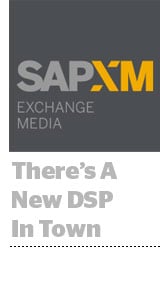 SAP entered the digital advertising market this week, creating a DSP and DMP from scratch it’s dubbing SAP Exchange Media (XM).
SAP entered the digital advertising market this week, creating a DSP and DMP from scratch it’s dubbing SAP Exchange Media (XM).
Wolfgang Faisst, co-founder and head of SAP XM, acknowledged that despite an ecosystem of “thousands of ad tech companies,” SAP decided to step up because of demand for end-to-end integration.
Because SAP XM connects with SAP’s ecommerce platform hybris and other back office software, it can deploy a company’s data seamlessly and in privacy-safe ways for advertising campaigns. Campaigns end up with more precise targeting and measurement.
That solves two key business problems. First, it allows marketers to easily access and deploy first-party data that lives behind a firewall, including data that lives in SAP’s ecommerce platform hybris. Clients can target using customer profiles with purchase data or search history in a privacy-safe way.
“All of this is currently not used to make better advertising, because it’s behind the firewall,” Faisst said. “We assure the highest level of the privacy because we are a European company.”
Second, SAP XM provides in-depth analytics that help CMOs justify their marketing spend in ways that make sense to CFOs. “The CFOs expect real numbers,” Faisst said, not proxy metrics like clicks. SAP XM will track additional purchases that happen in the ecommerce platform and tie that back to advertising campaigns, providing a “transparent view on the incremental business.”
SAP XM lets marketers spend in mobile web, app, desktop and digital out-of-home via open exchanges, private marketplaces and directly with publishers.
SAP also is working on the connected car business and is prepping to enable Internet of Things advertising.
Faisst first started working on XM a year and a half ago, when it was given the green light to operate as a startup within SAP. Ninety people are dedicated to SAP XM, and it also leans on other company resources, like an architecture consulting team, a sales force and in-memory database SAP HANA – which according to Faisst lets SAP XM deploy more efficiently and harness more complex algorithms.
SAP expects marketers, agencies and consultants to be the main customers of the platform. Beiersdorf (NIVEA), Deutsche Post DHL Group and EY (both as an advertiser and as a consultant) have signed on, as well as advertising agencies vertical, Jung von Matt and SinnerSchrader.
SAP is purposely using a business model it feels is transparent and will charge XM customers a flat percentage for the media spend that goes through the platform.
SAP is also partnering with a number of ad tech companies including PubMatic (whose CEO used to work at SAP). Faisst also expressed optimism getting other ad tech companies on board. SAP-owned firm Sapphire Ventures invested in Krux, Faisst said, “and therefore [is] an ideal partner on the DMP side.”
The enterprise giant expects to add more ad tech partners soon, including video platforms. It also is developing direct-to-publisher relationships, including with airport app FLIO and Tank & Rast, which has an autobahn app.
Although it does not provide ad exchange capabilities, Faisst said it was a possibility.
“We want to transform advertising to an efficient business from the fragmentation that exists today,” Faisst said.













